Project Management Report: Analysis of Balfour Beatty Project (2018)
VerifiedAdded on 2023/02/02
|12
|3577
|90
Report
AI Summary
This report provides a comprehensive analysis of project management principles, specifically focusing on the context of Balfour Beatty's expansion project for Open University. It begins with an introduction to project management and its significance, followed by an executive summary. The report then delves into key components, including project initiation documents that outline objectives, scope, and stakeholder information. It discusses the importance of Gantt charts and work breakdown structures for task management and scheduling. A detailed examination of risk registers highlights potential challenges and mitigation strategies. Furthermore, the report includes a simulated report to project sponsors and the director of operations, emphasizing the importance of effective communication and management. The report also covers the PRINCE2 methodology and stakeholder analysis. The report emphasizes the importance of project management tools and methodologies for achieving project success, and the importance of the project manager and team in the project.

Project Management
Paraphrase This Document
Need a fresh take? Get an instant paraphrase of this document with our AI Paraphraser
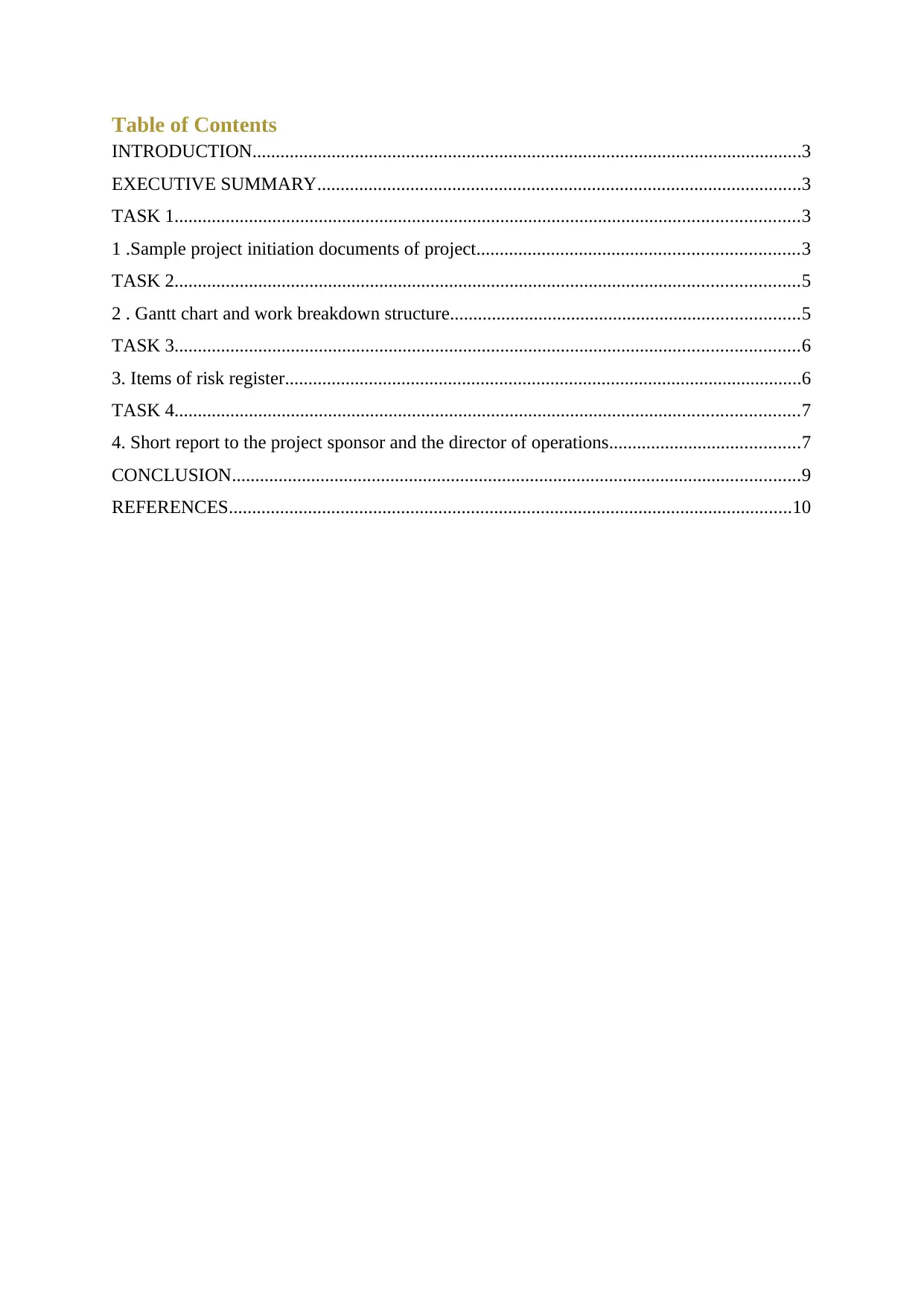
Table of Contents
INTRODUCTION......................................................................................................................3
EXECUTIVE SUMMARY........................................................................................................3
TASK 1......................................................................................................................................3
1 .Sample project initiation documents of project.....................................................................3
TASK 2......................................................................................................................................5
2 . Gantt chart and work breakdown structure...........................................................................5
TASK 3......................................................................................................................................6
3. Items of risk register...............................................................................................................6
TASK 4......................................................................................................................................7
4. Short report to the project sponsor and the director of operations.........................................7
CONCLUSION..........................................................................................................................9
REFERENCES.........................................................................................................................10
INTRODUCTION......................................................................................................................3
EXECUTIVE SUMMARY........................................................................................................3
TASK 1......................................................................................................................................3
1 .Sample project initiation documents of project.....................................................................3
TASK 2......................................................................................................................................5
2 . Gantt chart and work breakdown structure...........................................................................5
TASK 3......................................................................................................................................6
3. Items of risk register...............................................................................................................6
TASK 4......................................................................................................................................7
4. Short report to the project sponsor and the director of operations.........................................7
CONCLUSION..........................................................................................................................9
REFERENCES.........................................................................................................................10
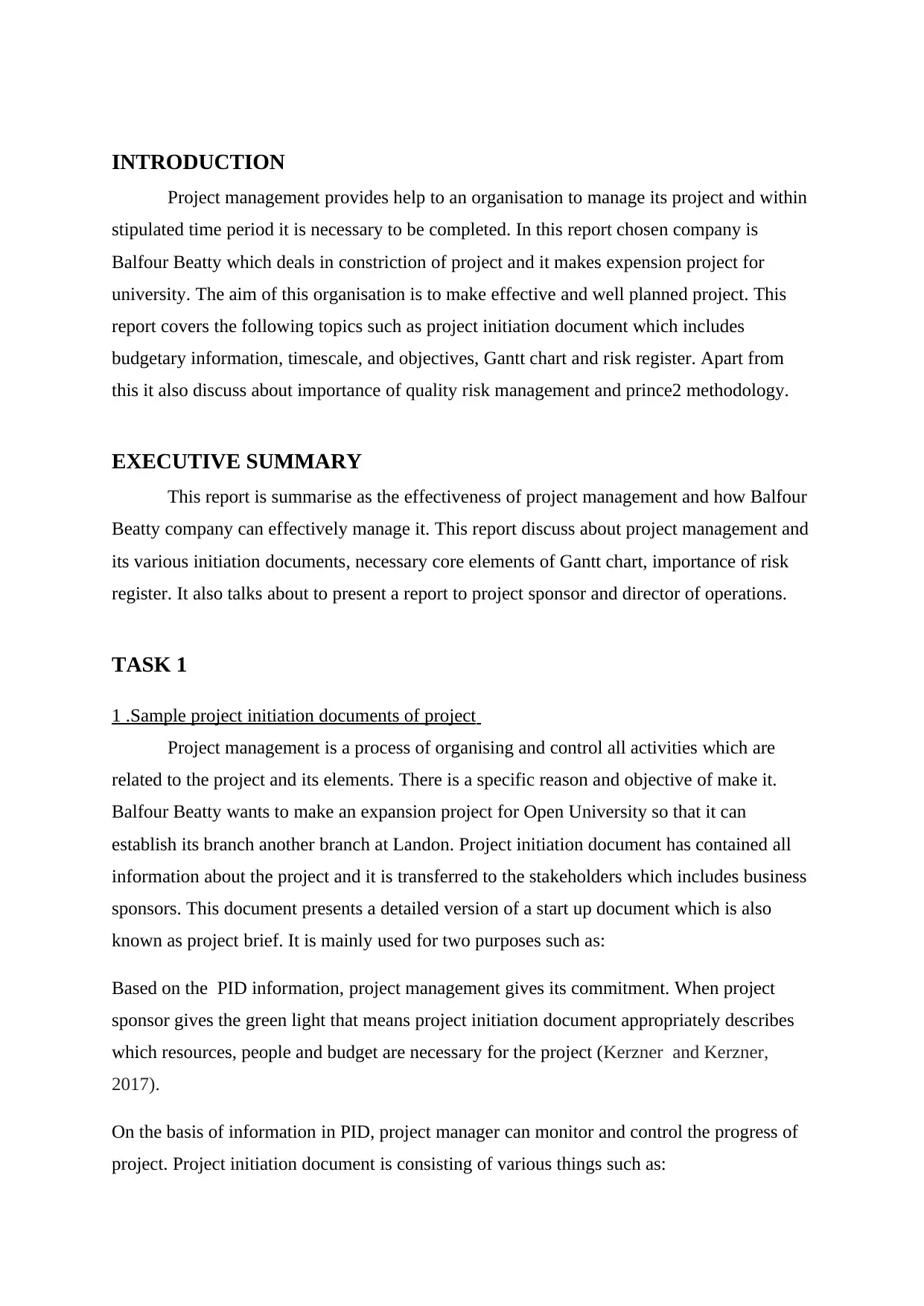
INTRODUCTION
Project management provides help to an organisation to manage its project and within
stipulated time period it is necessary to be completed. In this report chosen company is
Balfour Beatty which deals in constriction of project and it makes expension project for
university. The aim of this organisation is to make effective and well planned project. This
report covers the following topics such as project initiation document which includes
budgetary information, timescale, and objectives, Gantt chart and risk register. Apart from
this it also discuss about importance of quality risk management and prince2 methodology.
EXECUTIVE SUMMARY
This report is summarise as the effectiveness of project management and how Balfour
Beatty company can effectively manage it. This report discuss about project management and
its various initiation documents, necessary core elements of Gantt chart, importance of risk
register. It also talks about to present a report to project sponsor and director of operations.
TASK 1
1 .Sample project initiation documents of project
Project management is a process of organising and control all activities which are
related to the project and its elements. There is a specific reason and objective of make it.
Balfour Beatty wants to make an expansion project for Open University so that it can
establish its branch another branch at Landon. Project initiation document has contained all
information about the project and it is transferred to the stakeholders which includes business
sponsors. This document presents a detailed version of a start up document which is also
known as project brief. It is mainly used for two purposes such as:
Based on the PID information, project management gives its commitment. When project
sponsor gives the green light that means project initiation document appropriately describes
which resources, people and budget are necessary for the project (Kerzner and Kerzner,
2017).
On the basis of information in PID, project manager can monitor and control the progress of
project. Project initiation document is consisting of various things such as:
Project management provides help to an organisation to manage its project and within
stipulated time period it is necessary to be completed. In this report chosen company is
Balfour Beatty which deals in constriction of project and it makes expension project for
university. The aim of this organisation is to make effective and well planned project. This
report covers the following topics such as project initiation document which includes
budgetary information, timescale, and objectives, Gantt chart and risk register. Apart from
this it also discuss about importance of quality risk management and prince2 methodology.
EXECUTIVE SUMMARY
This report is summarise as the effectiveness of project management and how Balfour
Beatty company can effectively manage it. This report discuss about project management and
its various initiation documents, necessary core elements of Gantt chart, importance of risk
register. It also talks about to present a report to project sponsor and director of operations.
TASK 1
1 .Sample project initiation documents of project
Project management is a process of organising and control all activities which are
related to the project and its elements. There is a specific reason and objective of make it.
Balfour Beatty wants to make an expansion project for Open University so that it can
establish its branch another branch at Landon. Project initiation document has contained all
information about the project and it is transferred to the stakeholders which includes business
sponsors. This document presents a detailed version of a start up document which is also
known as project brief. It is mainly used for two purposes such as:
Based on the PID information, project management gives its commitment. When project
sponsor gives the green light that means project initiation document appropriately describes
which resources, people and budget are necessary for the project (Kerzner and Kerzner,
2017).
On the basis of information in PID, project manager can monitor and control the progress of
project. Project initiation document is consisting of various things such as:
⊘ This is a preview!⊘
Do you want full access?
Subscribe today to unlock all pages.

Trusted by 1+ million students worldwide
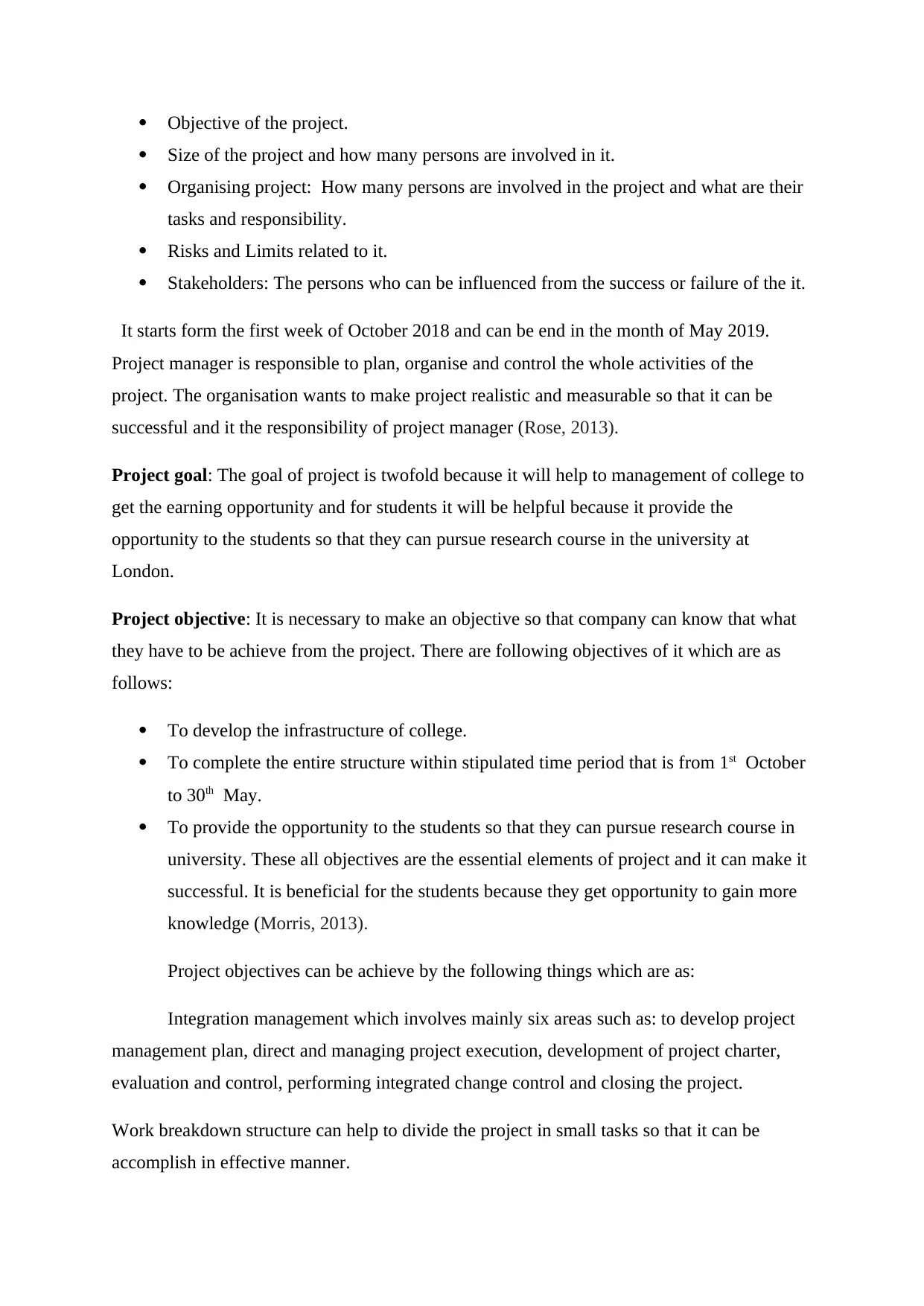
Objective of the project.
Size of the project and how many persons are involved in it.
Organising project: How many persons are involved in the project and what are their
tasks and responsibility.
Risks and Limits related to it.
Stakeholders: The persons who can be influenced from the success or failure of the it.
It starts form the first week of October 2018 and can be end in the month of May 2019.
Project manager is responsible to plan, organise and control the whole activities of the
project. The organisation wants to make project realistic and measurable so that it can be
successful and it the responsibility of project manager (Rose, 2013).
Project goal: The goal of project is twofold because it will help to management of college to
get the earning opportunity and for students it will be helpful because it provide the
opportunity to the students so that they can pursue research course in the university at
London.
Project objective: It is necessary to make an objective so that company can know that what
they have to be achieve from the project. There are following objectives of it which are as
follows:
To develop the infrastructure of college.
To complete the entire structure within stipulated time period that is from 1st October
to 30th May.
To provide the opportunity to the students so that they can pursue research course in
university. These all objectives are the essential elements of project and it can make it
successful. It is beneficial for the students because they get opportunity to gain more
knowledge (Morris, 2013).
Project objectives can be achieve by the following things which are as:
Integration management which involves mainly six areas such as: to develop project
management plan, direct and managing project execution, development of project charter,
evaluation and control, performing integrated change control and closing the project.
Work breakdown structure can help to divide the project in small tasks so that it can be
accomplish in effective manner.
Size of the project and how many persons are involved in it.
Organising project: How many persons are involved in the project and what are their
tasks and responsibility.
Risks and Limits related to it.
Stakeholders: The persons who can be influenced from the success or failure of the it.
It starts form the first week of October 2018 and can be end in the month of May 2019.
Project manager is responsible to plan, organise and control the whole activities of the
project. The organisation wants to make project realistic and measurable so that it can be
successful and it the responsibility of project manager (Rose, 2013).
Project goal: The goal of project is twofold because it will help to management of college to
get the earning opportunity and for students it will be helpful because it provide the
opportunity to the students so that they can pursue research course in the university at
London.
Project objective: It is necessary to make an objective so that company can know that what
they have to be achieve from the project. There are following objectives of it which are as
follows:
To develop the infrastructure of college.
To complete the entire structure within stipulated time period that is from 1st October
to 30th May.
To provide the opportunity to the students so that they can pursue research course in
university. These all objectives are the essential elements of project and it can make it
successful. It is beneficial for the students because they get opportunity to gain more
knowledge (Morris, 2013).
Project objectives can be achieve by the following things which are as:
Integration management which involves mainly six areas such as: to develop project
management plan, direct and managing project execution, development of project charter,
evaluation and control, performing integrated change control and closing the project.
Work breakdown structure can help to divide the project in small tasks so that it can be
accomplish in effective manner.
Paraphrase This Document
Need a fresh take? Get an instant paraphrase of this document with our AI Paraphraser
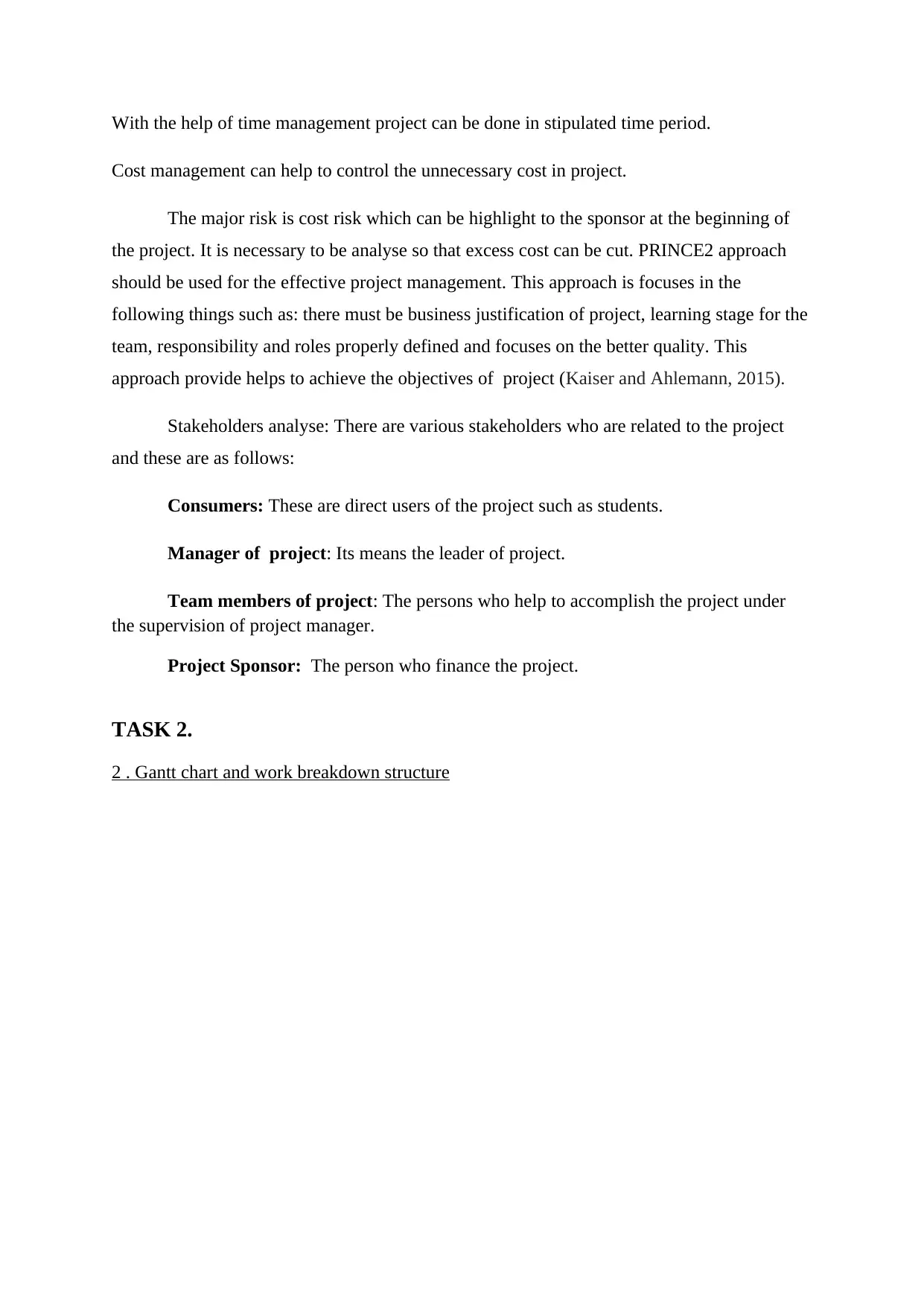
With the help of time management project can be done in stipulated time period.
Cost management can help to control the unnecessary cost in project.
The major risk is cost risk which can be highlight to the sponsor at the beginning of
the project. It is necessary to be analyse so that excess cost can be cut. PRINCE2 approach
should be used for the effective project management. This approach is focuses in the
following things such as: there must be business justification of project, learning stage for the
team, responsibility and roles properly defined and focuses on the better quality. This
approach provide helps to achieve the objectives of project (Kaiser and Ahlemann, 2015).
Stakeholders analyse: There are various stakeholders who are related to the project
and these are as follows:
Consumers: These are direct users of the project such as students.
Manager of project: Its means the leader of project.
Team members of project: The persons who help to accomplish the project under
the supervision of project manager.
Project Sponsor: The person who finance the project.
TASK 2.
2 . Gantt chart and work breakdown structure
Cost management can help to control the unnecessary cost in project.
The major risk is cost risk which can be highlight to the sponsor at the beginning of
the project. It is necessary to be analyse so that excess cost can be cut. PRINCE2 approach
should be used for the effective project management. This approach is focuses in the
following things such as: there must be business justification of project, learning stage for the
team, responsibility and roles properly defined and focuses on the better quality. This
approach provide helps to achieve the objectives of project (Kaiser and Ahlemann, 2015).
Stakeholders analyse: There are various stakeholders who are related to the project
and these are as follows:
Consumers: These are direct users of the project such as students.
Manager of project: Its means the leader of project.
Team members of project: The persons who help to accomplish the project under
the supervision of project manager.
Project Sponsor: The person who finance the project.
TASK 2.
2 . Gantt chart and work breakdown structure
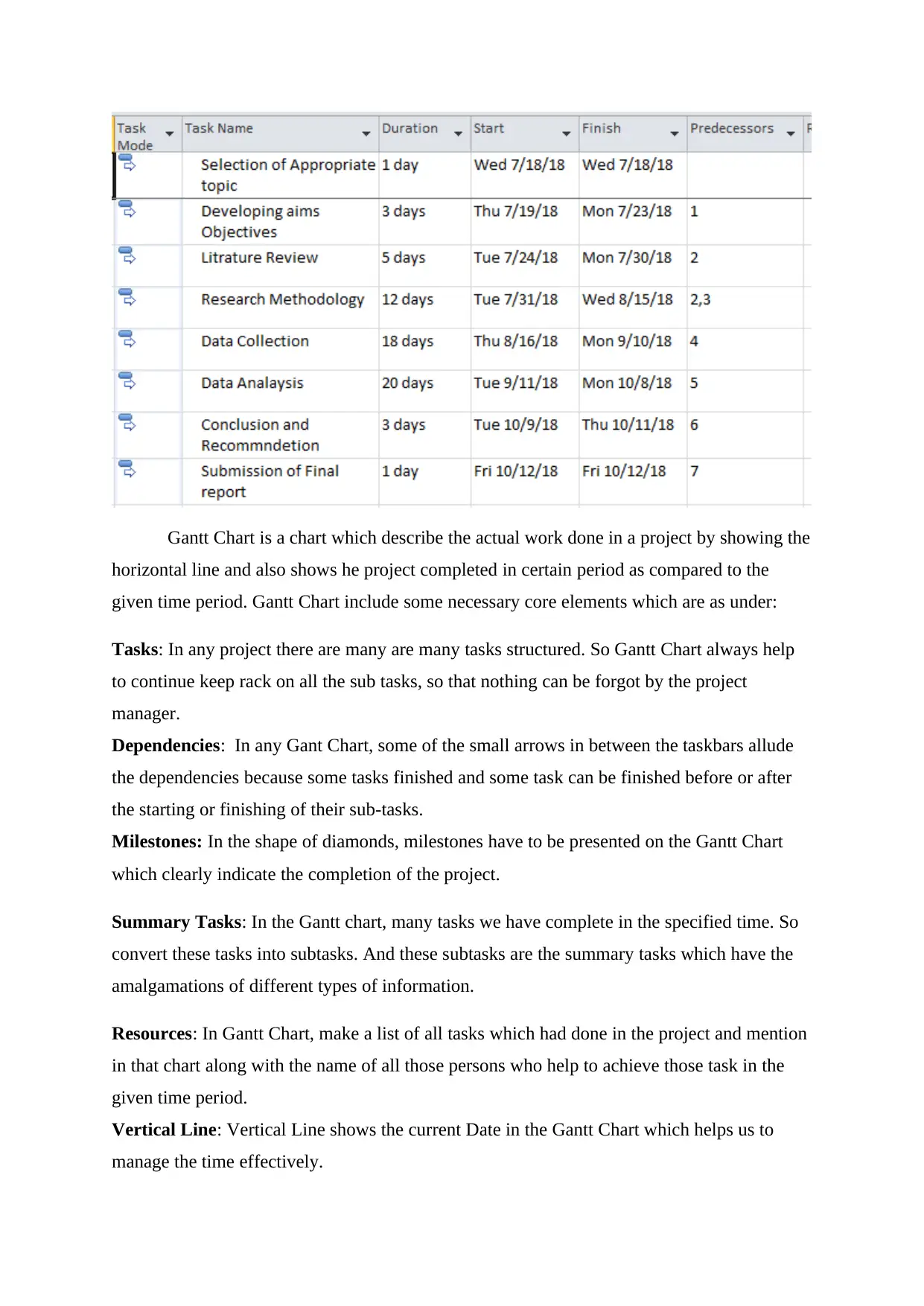
Gantt Chart is a chart which describe the actual work done in a project by showing the
horizontal line and also shows he project completed in certain period as compared to the
given time period. Gantt Chart include some necessary core elements which are as under:
Tasks: In any project there are many are many tasks structured. So Gantt Chart always help
to continue keep rack on all the sub tasks, so that nothing can be forgot by the project
manager.
Dependencies: In any Gant Chart, some of the small arrows in between the taskbars allude
the dependencies because some tasks finished and some task can be finished before or after
the starting or finishing of their sub-tasks.
Milestones: In the shape of diamonds, milestones have to be presented on the Gantt Chart
which clearly indicate the completion of the project.
Summary Tasks: In the Gantt chart, many tasks we have complete in the specified time. So
convert these tasks into subtasks. And these subtasks are the summary tasks which have the
amalgamations of different types of information.
Resources: In Gantt Chart, make a list of all tasks which had done in the project and mention
in that chart along with the name of all those persons who help to achieve those task in the
given time period.
Vertical Line: Vertical Line shows the current Date in the Gantt Chart which helps us to
manage the time effectively.
horizontal line and also shows he project completed in certain period as compared to the
given time period. Gantt Chart include some necessary core elements which are as under:
Tasks: In any project there are many are many tasks structured. So Gantt Chart always help
to continue keep rack on all the sub tasks, so that nothing can be forgot by the project
manager.
Dependencies: In any Gant Chart, some of the small arrows in between the taskbars allude
the dependencies because some tasks finished and some task can be finished before or after
the starting or finishing of their sub-tasks.
Milestones: In the shape of diamonds, milestones have to be presented on the Gantt Chart
which clearly indicate the completion of the project.
Summary Tasks: In the Gantt chart, many tasks we have complete in the specified time. So
convert these tasks into subtasks. And these subtasks are the summary tasks which have the
amalgamations of different types of information.
Resources: In Gantt Chart, make a list of all tasks which had done in the project and mention
in that chart along with the name of all those persons who help to achieve those task in the
given time period.
Vertical Line: Vertical Line shows the current Date in the Gantt Chart which helps us to
manage the time effectively.
⊘ This is a preview!⊘
Do you want full access?
Subscribe today to unlock all pages.

Trusted by 1+ million students worldwide
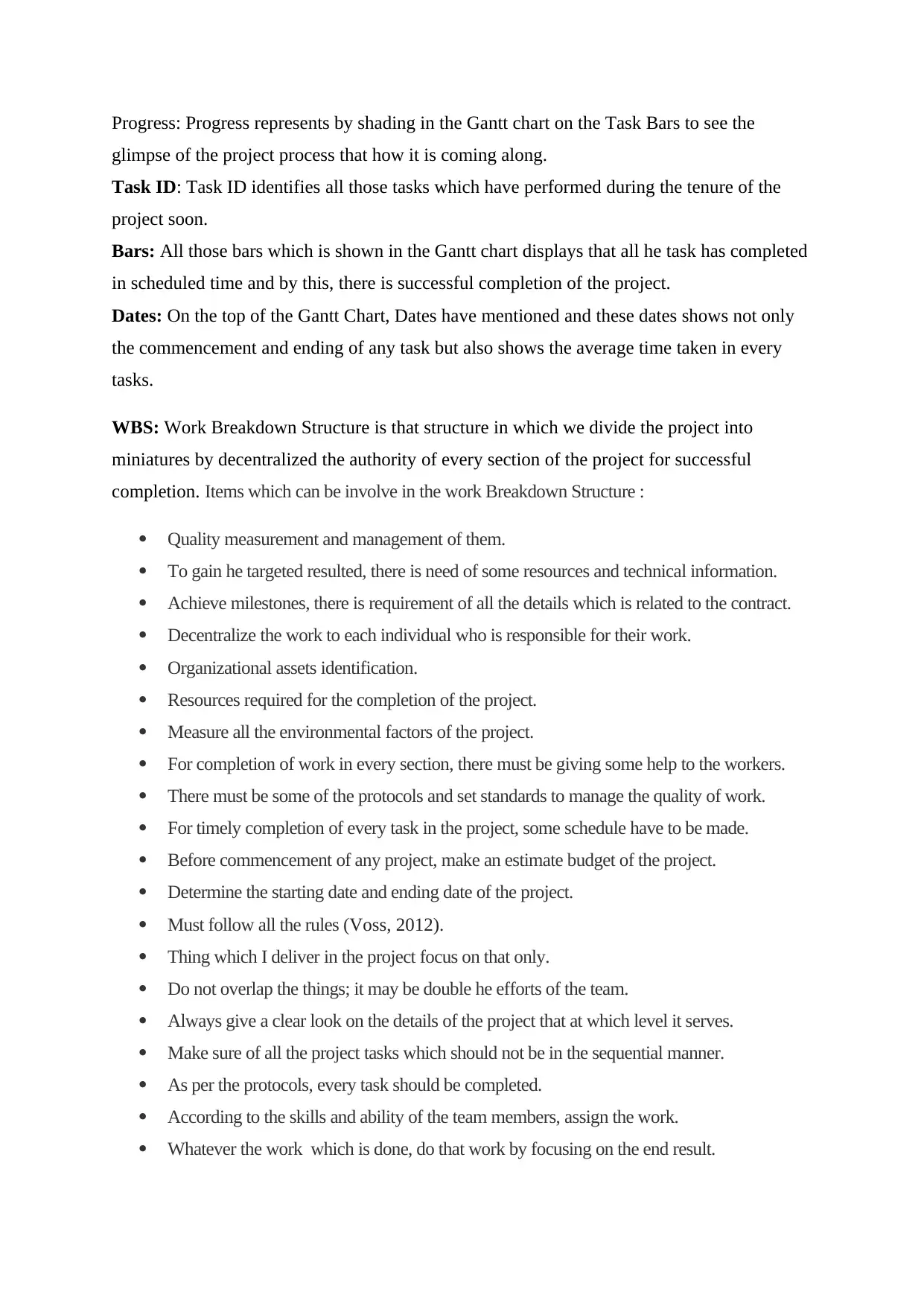
Progress: Progress represents by shading in the Gantt chart on the Task Bars to see the
glimpse of the project process that how it is coming along.
Task ID: Task ID identifies all those tasks which have performed during the tenure of the
project soon.
Bars: All those bars which is shown in the Gantt chart displays that all he task has completed
in scheduled time and by this, there is successful completion of the project.
Dates: On the top of the Gantt Chart, Dates have mentioned and these dates shows not only
the commencement and ending of any task but also shows the average time taken in every
tasks.
WBS: Work Breakdown Structure is that structure in which we divide the project into
miniatures by decentralized the authority of every section of the project for successful
completion. Items which can be involve in the work Breakdown Structure :
Quality measurement and management of them.
To gain he targeted resulted, there is need of some resources and technical information.
Achieve milestones, there is requirement of all the details which is related to the contract.
Decentralize the work to each individual who is responsible for their work.
Organizational assets identification.
Resources required for the completion of the project.
Measure all the environmental factors of the project.
For completion of work in every section, there must be giving some help to the workers.
There must be some of the protocols and set standards to manage the quality of work.
For timely completion of every task in the project, some schedule have to be made.
Before commencement of any project, make an estimate budget of the project.
Determine the starting date and ending date of the project.
Must follow all the rules (Voss, 2012).
Thing which I deliver in the project focus on that only.
Do not overlap the things; it may be double he efforts of the team.
Always give a clear look on the details of the project that at which level it serves.
Make sure of all the project tasks which should not be in the sequential manner.
As per the protocols, every task should be completed.
According to the skills and ability of the team members, assign the work.
Whatever the work which is done, do that work by focusing on the end result.
glimpse of the project process that how it is coming along.
Task ID: Task ID identifies all those tasks which have performed during the tenure of the
project soon.
Bars: All those bars which is shown in the Gantt chart displays that all he task has completed
in scheduled time and by this, there is successful completion of the project.
Dates: On the top of the Gantt Chart, Dates have mentioned and these dates shows not only
the commencement and ending of any task but also shows the average time taken in every
tasks.
WBS: Work Breakdown Structure is that structure in which we divide the project into
miniatures by decentralized the authority of every section of the project for successful
completion. Items which can be involve in the work Breakdown Structure :
Quality measurement and management of them.
To gain he targeted resulted, there is need of some resources and technical information.
Achieve milestones, there is requirement of all the details which is related to the contract.
Decentralize the work to each individual who is responsible for their work.
Organizational assets identification.
Resources required for the completion of the project.
Measure all the environmental factors of the project.
For completion of work in every section, there must be giving some help to the workers.
There must be some of the protocols and set standards to manage the quality of work.
For timely completion of every task in the project, some schedule have to be made.
Before commencement of any project, make an estimate budget of the project.
Determine the starting date and ending date of the project.
Must follow all the rules (Voss, 2012).
Thing which I deliver in the project focus on that only.
Do not overlap the things; it may be double he efforts of the team.
Always give a clear look on the details of the project that at which level it serves.
Make sure of all the project tasks which should not be in the sequential manner.
As per the protocols, every task should be completed.
According to the skills and ability of the team members, assign the work.
Whatever the work which is done, do that work by focusing on the end result.
Paraphrase This Document
Need a fresh take? Get an instant paraphrase of this document with our AI Paraphraser
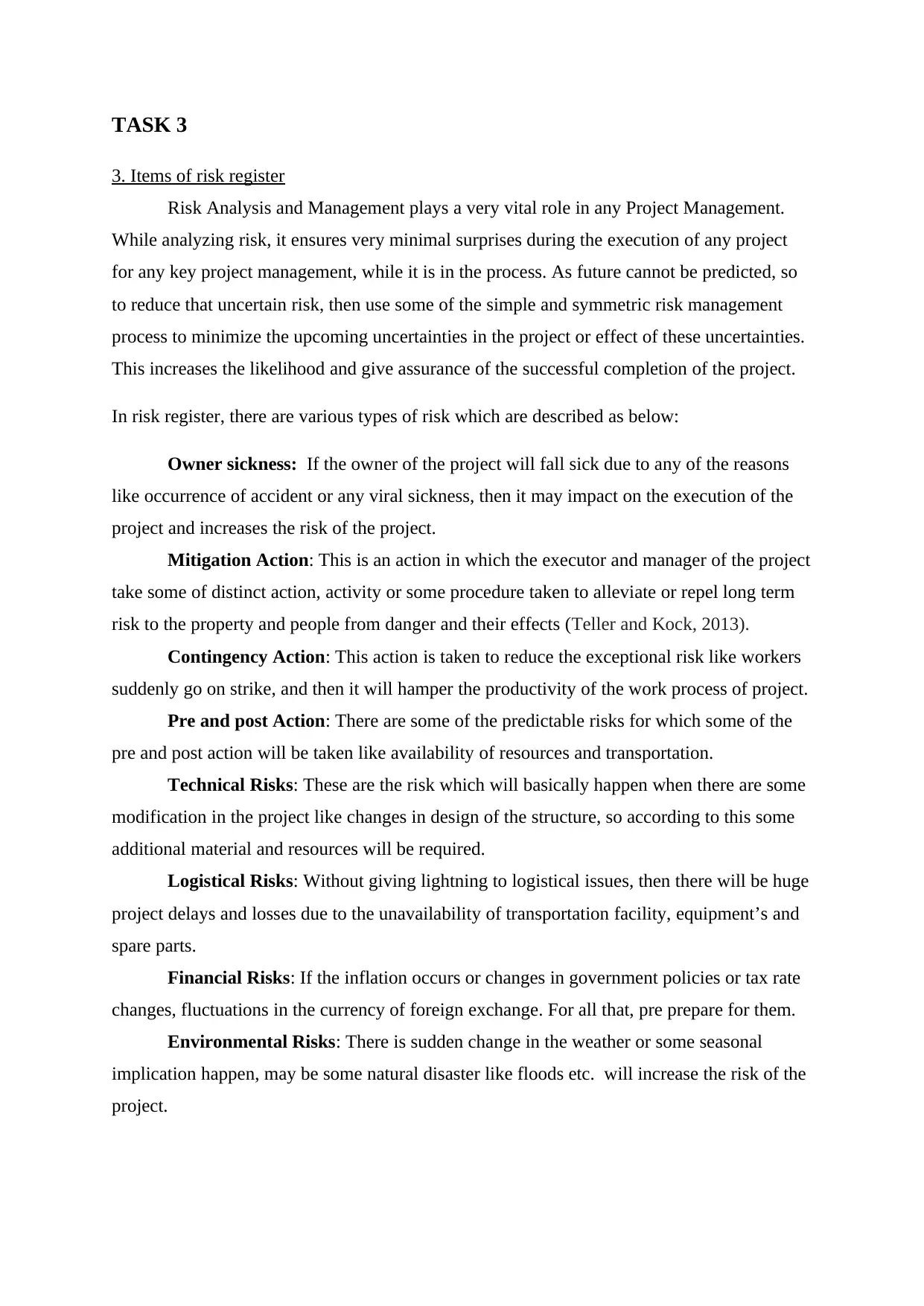
TASK 3
3. Items of risk register
Risk Analysis and Management plays a very vital role in any Project Management.
While analyzing risk, it ensures very minimal surprises during the execution of any project
for any key project management, while it is in the process. As future cannot be predicted, so
to reduce that uncertain risk, then use some of the simple and symmetric risk management
process to minimize the upcoming uncertainties in the project or effect of these uncertainties.
This increases the likelihood and give assurance of the successful completion of the project.
In risk register, there are various types of risk which are described as below:
Owner sickness: If the owner of the project will fall sick due to any of the reasons
like occurrence of accident or any viral sickness, then it may impact on the execution of the
project and increases the risk of the project.
Mitigation Action: This is an action in which the executor and manager of the project
take some of distinct action, activity or some procedure taken to alleviate or repel long term
risk to the property and people from danger and their effects (Teller and Kock, 2013).
Contingency Action: This action is taken to reduce the exceptional risk like workers
suddenly go on strike, and then it will hamper the productivity of the work process of project.
Pre and post Action: There are some of the predictable risks for which some of the
pre and post action will be taken like availability of resources and transportation.
Technical Risks: These are the risk which will basically happen when there are some
modification in the project like changes in design of the structure, so according to this some
additional material and resources will be required.
Logistical Risks: Without giving lightning to logistical issues, then there will be huge
project delays and losses due to the unavailability of transportation facility, equipment’s and
spare parts.
Financial Risks: If the inflation occurs or changes in government policies or tax rate
changes, fluctuations in the currency of foreign exchange. For all that, pre prepare for them.
Environmental Risks: There is sudden change in the weather or some seasonal
implication happen, may be some natural disaster like floods etc. will increase the risk of the
project.
3. Items of risk register
Risk Analysis and Management plays a very vital role in any Project Management.
While analyzing risk, it ensures very minimal surprises during the execution of any project
for any key project management, while it is in the process. As future cannot be predicted, so
to reduce that uncertain risk, then use some of the simple and symmetric risk management
process to minimize the upcoming uncertainties in the project or effect of these uncertainties.
This increases the likelihood and give assurance of the successful completion of the project.
In risk register, there are various types of risk which are described as below:
Owner sickness: If the owner of the project will fall sick due to any of the reasons
like occurrence of accident or any viral sickness, then it may impact on the execution of the
project and increases the risk of the project.
Mitigation Action: This is an action in which the executor and manager of the project
take some of distinct action, activity or some procedure taken to alleviate or repel long term
risk to the property and people from danger and their effects (Teller and Kock, 2013).
Contingency Action: This action is taken to reduce the exceptional risk like workers
suddenly go on strike, and then it will hamper the productivity of the work process of project.
Pre and post Action: There are some of the predictable risks for which some of the
pre and post action will be taken like availability of resources and transportation.
Technical Risks: These are the risk which will basically happen when there are some
modification in the project like changes in design of the structure, so according to this some
additional material and resources will be required.
Logistical Risks: Without giving lightning to logistical issues, then there will be huge
project delays and losses due to the unavailability of transportation facility, equipment’s and
spare parts.
Financial Risks: If the inflation occurs or changes in government policies or tax rate
changes, fluctuations in the currency of foreign exchange. For all that, pre prepare for them.
Environmental Risks: There is sudden change in the weather or some seasonal
implication happen, may be some natural disaster like floods etc. will increase the risk of the
project.
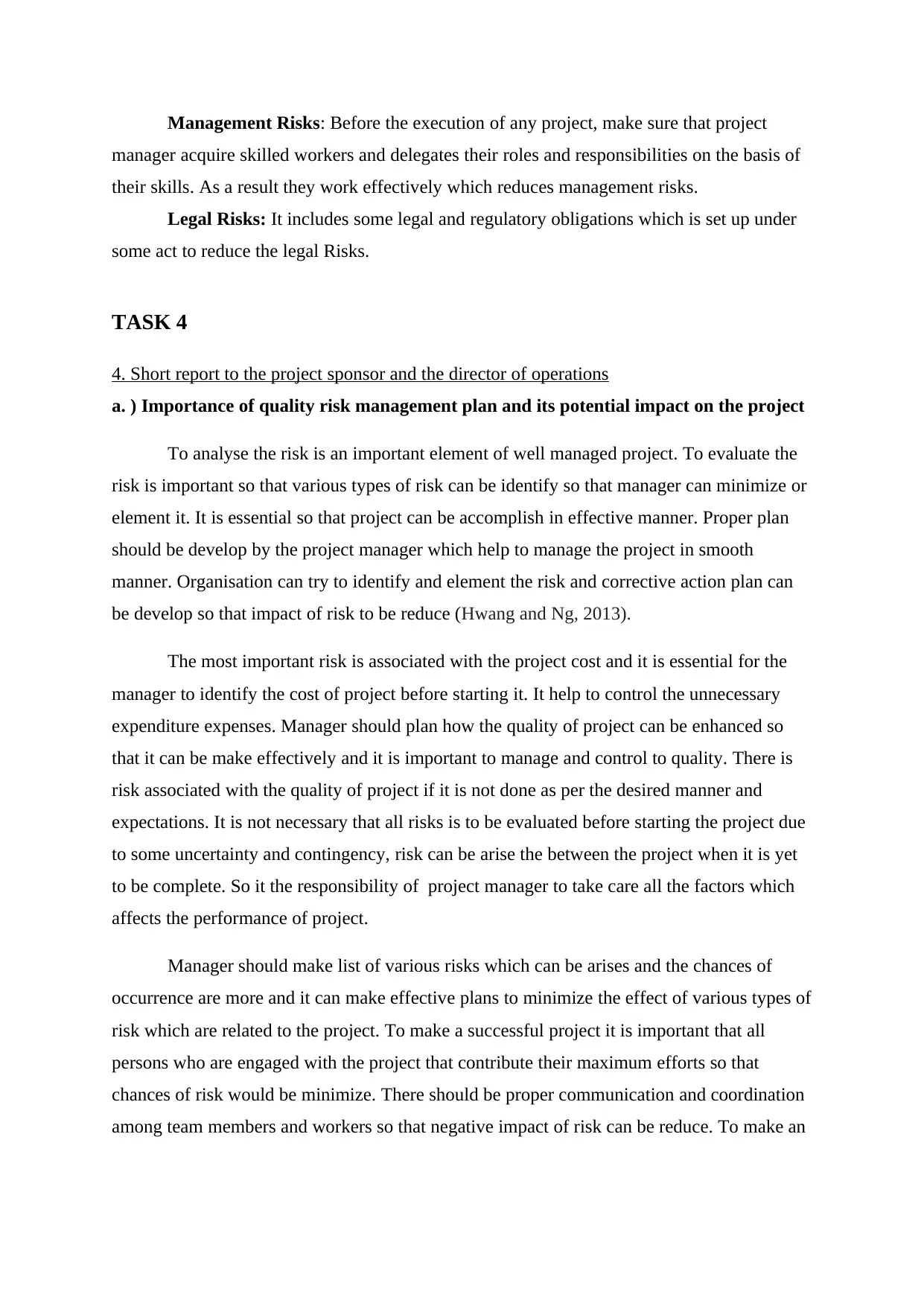
Management Risks: Before the execution of any project, make sure that project
manager acquire skilled workers and delegates their roles and responsibilities on the basis of
their skills. As a result they work effectively which reduces management risks.
Legal Risks: It includes some legal and regulatory obligations which is set up under
some act to reduce the legal Risks.
TASK 4
4. Short report to the project sponsor and the director of operations
a. ) Importance of quality risk management plan and its potential impact on the project
To analyse the risk is an important element of well managed project. To evaluate the
risk is important so that various types of risk can be identify so that manager can minimize or
element it. It is essential so that project can be accomplish in effective manner. Proper plan
should be develop by the project manager which help to manage the project in smooth
manner. Organisation can try to identify and element the risk and corrective action plan can
be develop so that impact of risk to be reduce (Hwang and Ng, 2013).
The most important risk is associated with the project cost and it is essential for the
manager to identify the cost of project before starting it. It help to control the unnecessary
expenditure expenses. Manager should plan how the quality of project can be enhanced so
that it can be make effectively and it is important to manage and control to quality. There is
risk associated with the quality of project if it is not done as per the desired manner and
expectations. It is not necessary that all risks is to be evaluated before starting the project due
to some uncertainty and contingency, risk can be arise the between the project when it is yet
to be complete. So it the responsibility of project manager to take care all the factors which
affects the performance of project.
Manager should make list of various risks which can be arises and the chances of
occurrence are more and it can make effective plans to minimize the effect of various types of
risk which are related to the project. To make a successful project it is important that all
persons who are engaged with the project that contribute their maximum efforts so that
chances of risk would be minimize. There should be proper communication and coordination
among team members and workers so that negative impact of risk can be reduce. To make an
manager acquire skilled workers and delegates their roles and responsibilities on the basis of
their skills. As a result they work effectively which reduces management risks.
Legal Risks: It includes some legal and regulatory obligations which is set up under
some act to reduce the legal Risks.
TASK 4
4. Short report to the project sponsor and the director of operations
a. ) Importance of quality risk management plan and its potential impact on the project
To analyse the risk is an important element of well managed project. To evaluate the
risk is important so that various types of risk can be identify so that manager can minimize or
element it. It is essential so that project can be accomplish in effective manner. Proper plan
should be develop by the project manager which help to manage the project in smooth
manner. Organisation can try to identify and element the risk and corrective action plan can
be develop so that impact of risk to be reduce (Hwang and Ng, 2013).
The most important risk is associated with the project cost and it is essential for the
manager to identify the cost of project before starting it. It help to control the unnecessary
expenditure expenses. Manager should plan how the quality of project can be enhanced so
that it can be make effectively and it is important to manage and control to quality. There is
risk associated with the quality of project if it is not done as per the desired manner and
expectations. It is not necessary that all risks is to be evaluated before starting the project due
to some uncertainty and contingency, risk can be arise the between the project when it is yet
to be complete. So it the responsibility of project manager to take care all the factors which
affects the performance of project.
Manager should make list of various risks which can be arises and the chances of
occurrence are more and it can make effective plans to minimize the effect of various types of
risk which are related to the project. To make a successful project it is important that all
persons who are engaged with the project that contribute their maximum efforts so that
chances of risk would be minimize. There should be proper communication and coordination
among team members and workers so that negative impact of risk can be reduce. To make an
⊘ This is a preview!⊘
Do you want full access?
Subscribe today to unlock all pages.

Trusted by 1+ million students worldwide
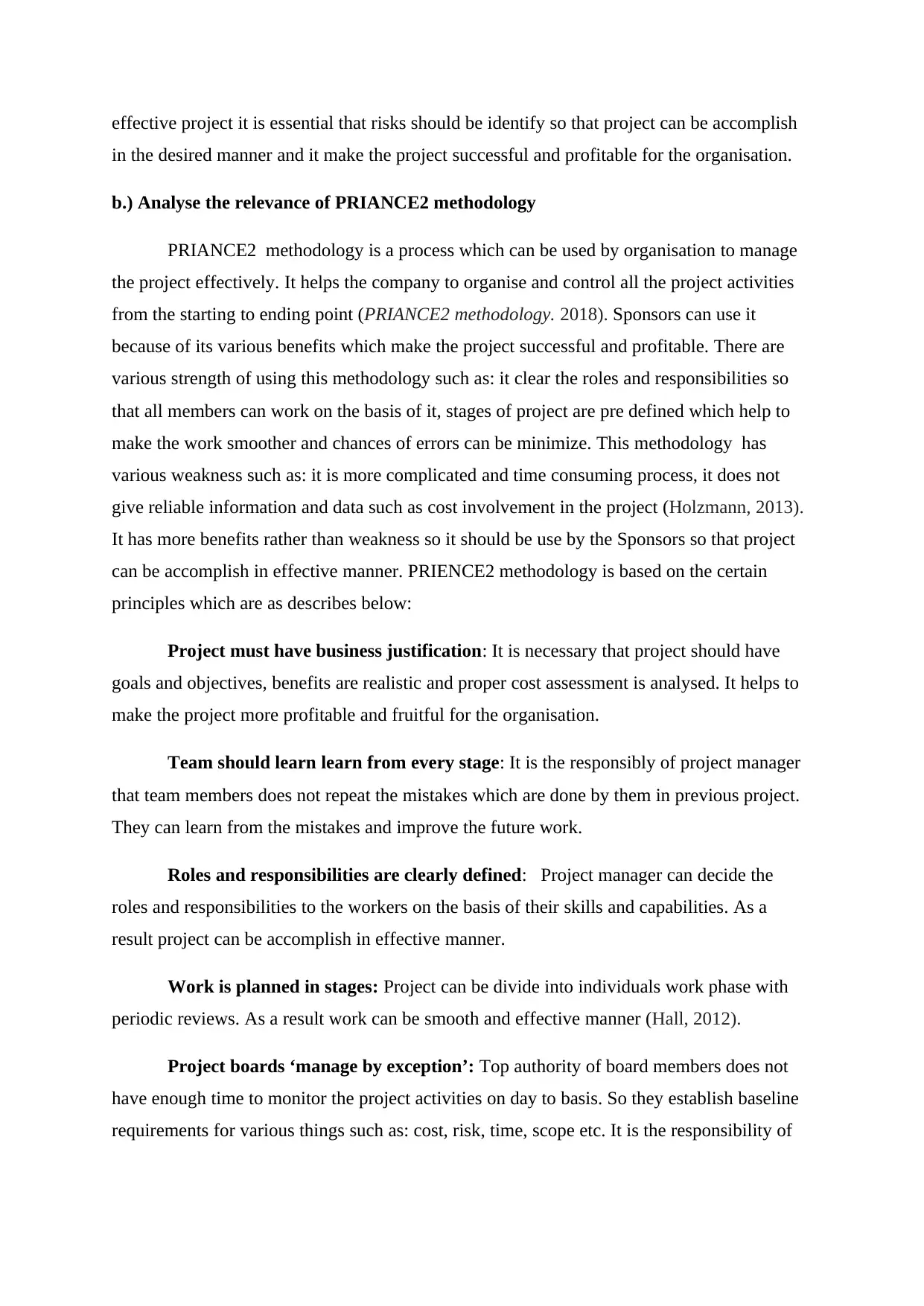
effective project it is essential that risks should be identify so that project can be accomplish
in the desired manner and it make the project successful and profitable for the organisation.
b.) Analyse the relevance of PRIANCE2 methodology
PRIANCE2 methodology is a process which can be used by organisation to manage
the project effectively. It helps the company to organise and control all the project activities
from the starting to ending point (PRIANCE2 methodology. 2018). Sponsors can use it
because of its various benefits which make the project successful and profitable. There are
various strength of using this methodology such as: it clear the roles and responsibilities so
that all members can work on the basis of it, stages of project are pre defined which help to
make the work smoother and chances of errors can be minimize. This methodology has
various weakness such as: it is more complicated and time consuming process, it does not
give reliable information and data such as cost involvement in the project (Holzmann, 2013).
It has more benefits rather than weakness so it should be use by the Sponsors so that project
can be accomplish in effective manner. PRIENCE2 methodology is based on the certain
principles which are as describes below:
Project must have business justification: It is necessary that project should have
goals and objectives, benefits are realistic and proper cost assessment is analysed. It helps to
make the project more profitable and fruitful for the organisation.
Team should learn learn from every stage: It is the responsibly of project manager
that team members does not repeat the mistakes which are done by them in previous project.
They can learn from the mistakes and improve the future work.
Roles and responsibilities are clearly defined: Project manager can decide the
roles and responsibilities to the workers on the basis of their skills and capabilities. As a
result project can be accomplish in effective manner.
Work is planned in stages: Project can be divide into individuals work phase with
periodic reviews. As a result work can be smooth and effective manner (Hall, 2012).
Project boards ‘manage by exception’: Top authority of board members does not
have enough time to monitor the project activities on day to basis. So they establish baseline
requirements for various things such as: cost, risk, time, scope etc. It is the responsibility of
in the desired manner and it make the project successful and profitable for the organisation.
b.) Analyse the relevance of PRIANCE2 methodology
PRIANCE2 methodology is a process which can be used by organisation to manage
the project effectively. It helps the company to organise and control all the project activities
from the starting to ending point (PRIANCE2 methodology. 2018). Sponsors can use it
because of its various benefits which make the project successful and profitable. There are
various strength of using this methodology such as: it clear the roles and responsibilities so
that all members can work on the basis of it, stages of project are pre defined which help to
make the work smoother and chances of errors can be minimize. This methodology has
various weakness such as: it is more complicated and time consuming process, it does not
give reliable information and data such as cost involvement in the project (Holzmann, 2013).
It has more benefits rather than weakness so it should be use by the Sponsors so that project
can be accomplish in effective manner. PRIENCE2 methodology is based on the certain
principles which are as describes below:
Project must have business justification: It is necessary that project should have
goals and objectives, benefits are realistic and proper cost assessment is analysed. It helps to
make the project more profitable and fruitful for the organisation.
Team should learn learn from every stage: It is the responsibly of project manager
that team members does not repeat the mistakes which are done by them in previous project.
They can learn from the mistakes and improve the future work.
Roles and responsibilities are clearly defined: Project manager can decide the
roles and responsibilities to the workers on the basis of their skills and capabilities. As a
result project can be accomplish in effective manner.
Work is planned in stages: Project can be divide into individuals work phase with
periodic reviews. As a result work can be smooth and effective manner (Hall, 2012).
Project boards ‘manage by exception’: Top authority of board members does not
have enough time to monitor the project activities on day to basis. So they establish baseline
requirements for various things such as: cost, risk, time, scope etc. It is the responsibility of
Paraphrase This Document
Need a fresh take? Get an instant paraphrase of this document with our AI Paraphraser
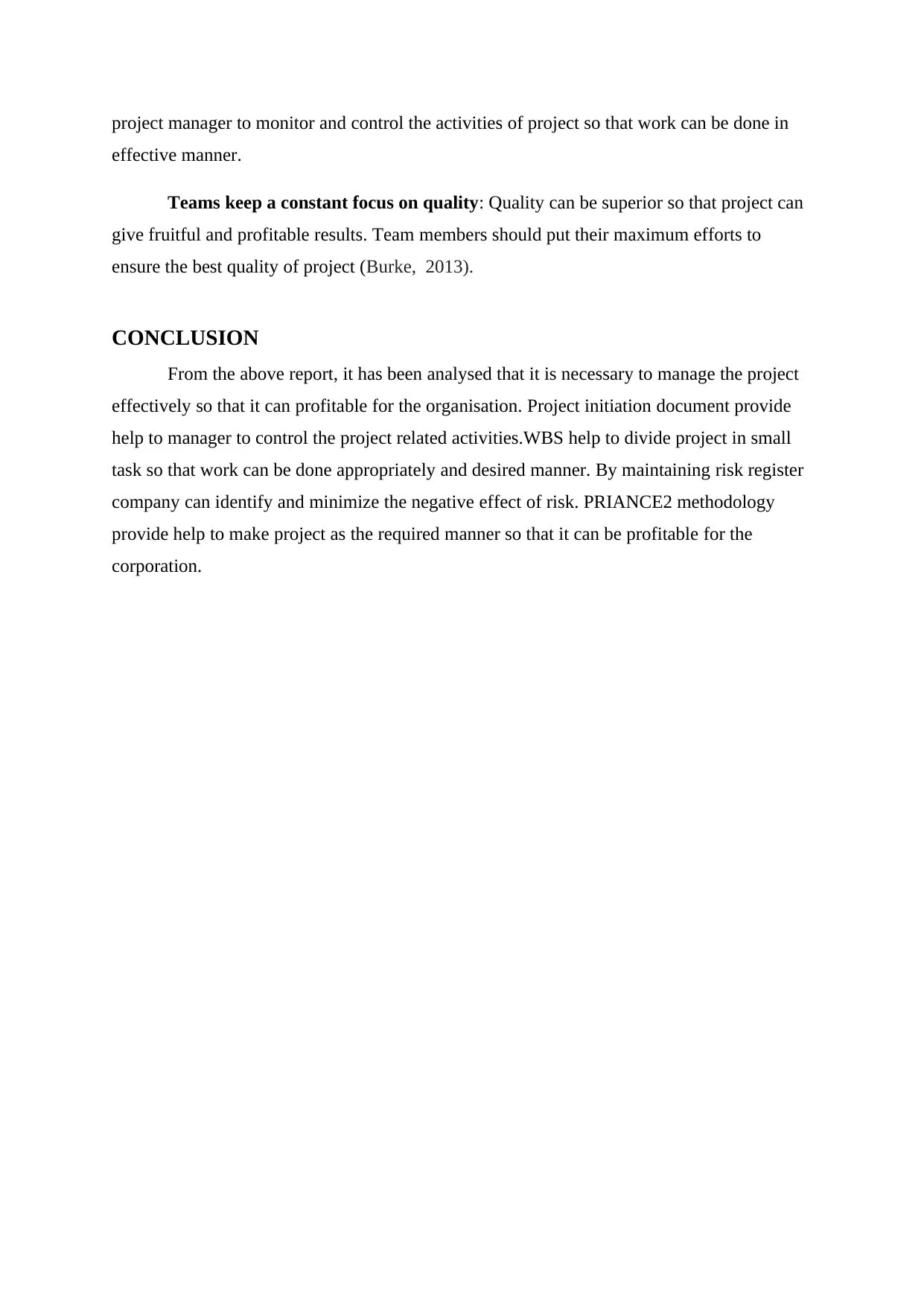
project manager to monitor and control the activities of project so that work can be done in
effective manner.
Teams keep a constant focus on quality: Quality can be superior so that project can
give fruitful and profitable results. Team members should put their maximum efforts to
ensure the best quality of project (Burke, 2013).
CONCLUSION
From the above report, it has been analysed that it is necessary to manage the project
effectively so that it can profitable for the organisation. Project initiation document provide
help to manager to control the project related activities.WBS help to divide project in small
task so that work can be done appropriately and desired manner. By maintaining risk register
company can identify and minimize the negative effect of risk. PRIANCE2 methodology
provide help to make project as the required manner so that it can be profitable for the
corporation.
effective manner.
Teams keep a constant focus on quality: Quality can be superior so that project can
give fruitful and profitable results. Team members should put their maximum efforts to
ensure the best quality of project (Burke, 2013).
CONCLUSION
From the above report, it has been analysed that it is necessary to manage the project
effectively so that it can profitable for the organisation. Project initiation document provide
help to manager to control the project related activities.WBS help to divide project in small
task so that work can be done appropriately and desired manner. By maintaining risk register
company can identify and minimize the negative effect of risk. PRIANCE2 methodology
provide help to make project as the required manner so that it can be profitable for the
corporation.
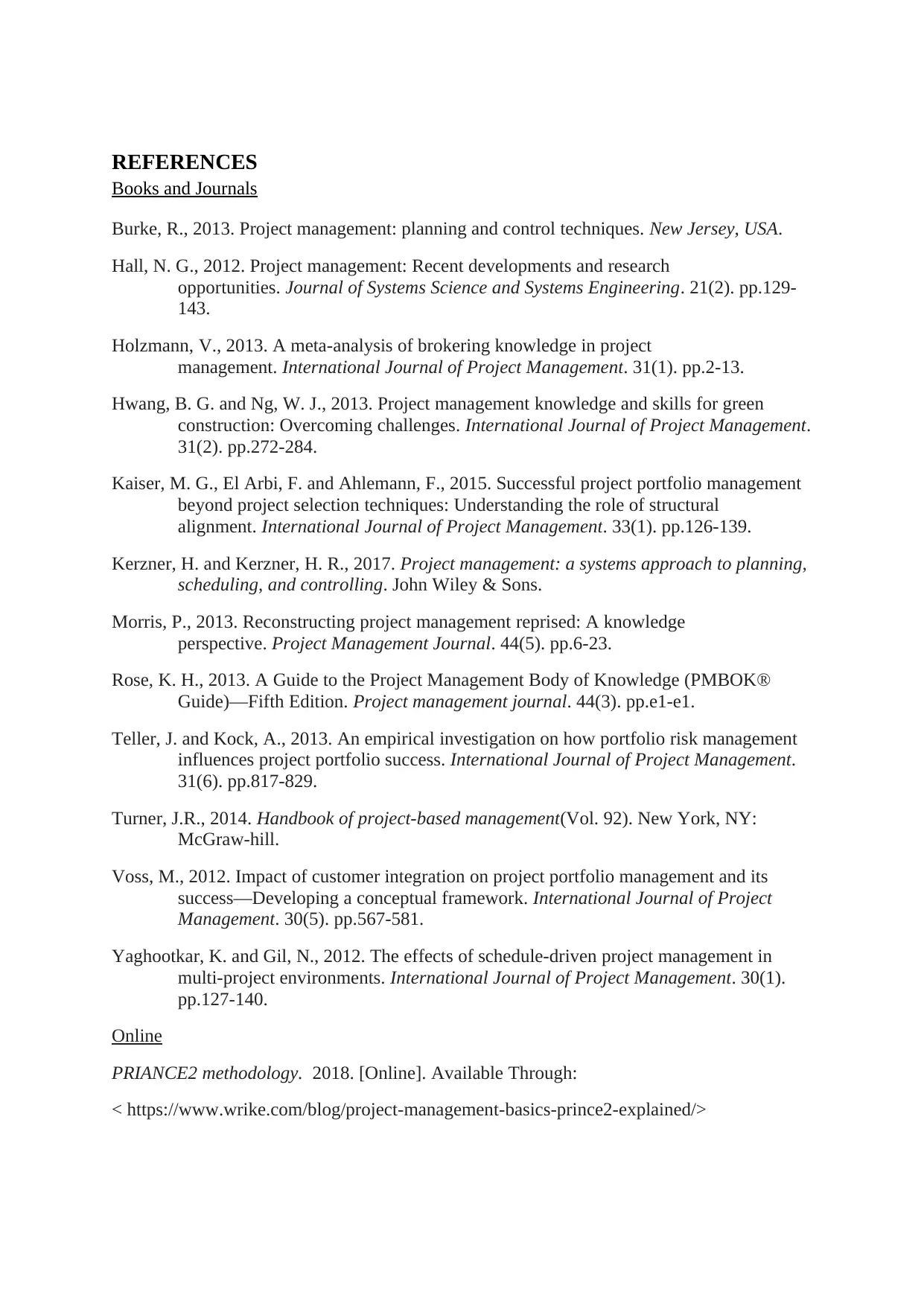
REFERENCES
Books and Journals
Burke, R., 2013. Project management: planning and control techniques. New Jersey, USA.
Hall, N. G., 2012. Project management: Recent developments and research
opportunities. Journal of Systems Science and Systems Engineering. 21(2). pp.129-
143.
Holzmann, V., 2013. A meta-analysis of brokering knowledge in project
management. International Journal of Project Management. 31(1). pp.2-13.
Hwang, B. G. and Ng, W. J., 2013. Project management knowledge and skills for green
construction: Overcoming challenges. International Journal of Project Management.
31(2). pp.272-284.
Kaiser, M. G., El Arbi, F. and Ahlemann, F., 2015. Successful project portfolio management
beyond project selection techniques: Understanding the role of structural
alignment. International Journal of Project Management. 33(1). pp.126-139.
Kerzner, H. and Kerzner, H. R., 2017. Project management: a systems approach to planning,
scheduling, and controlling. John Wiley & Sons.
Morris, P., 2013. Reconstructing project management reprised: A knowledge
perspective. Project Management Journal. 44(5). pp.6-23.
Rose, K. H., 2013. A Guide to the Project Management Body of Knowledge (PMBOK®
Guide)—Fifth Edition. Project management journal. 44(3). pp.e1-e1.
Teller, J. and Kock, A., 2013. An empirical investigation on how portfolio risk management
influences project portfolio success. International Journal of Project Management.
31(6). pp.817-829.
Turner, J.R., 2014. Handbook of project-based management(Vol. 92). New York, NY:
McGraw-hill.
Voss, M., 2012. Impact of customer integration on project portfolio management and its
success—Developing a conceptual framework. International Journal of Project
Management. 30(5). pp.567-581.
Yaghootkar, K. and Gil, N., 2012. The effects of schedule-driven project management in
multi-project environments. International Journal of Project Management. 30(1).
pp.127-140.
Online
PRIANCE2 methodology. 2018. [Online]. Available Through:
< https://www.wrike.com/blog/project-management-basics-prince2-explained/>
Books and Journals
Burke, R., 2013. Project management: planning and control techniques. New Jersey, USA.
Hall, N. G., 2012. Project management: Recent developments and research
opportunities. Journal of Systems Science and Systems Engineering. 21(2). pp.129-
143.
Holzmann, V., 2013. A meta-analysis of brokering knowledge in project
management. International Journal of Project Management. 31(1). pp.2-13.
Hwang, B. G. and Ng, W. J., 2013. Project management knowledge and skills for green
construction: Overcoming challenges. International Journal of Project Management.
31(2). pp.272-284.
Kaiser, M. G., El Arbi, F. and Ahlemann, F., 2015. Successful project portfolio management
beyond project selection techniques: Understanding the role of structural
alignment. International Journal of Project Management. 33(1). pp.126-139.
Kerzner, H. and Kerzner, H. R., 2017. Project management: a systems approach to planning,
scheduling, and controlling. John Wiley & Sons.
Morris, P., 2013. Reconstructing project management reprised: A knowledge
perspective. Project Management Journal. 44(5). pp.6-23.
Rose, K. H., 2013. A Guide to the Project Management Body of Knowledge (PMBOK®
Guide)—Fifth Edition. Project management journal. 44(3). pp.e1-e1.
Teller, J. and Kock, A., 2013. An empirical investigation on how portfolio risk management
influences project portfolio success. International Journal of Project Management.
31(6). pp.817-829.
Turner, J.R., 2014. Handbook of project-based management(Vol. 92). New York, NY:
McGraw-hill.
Voss, M., 2012. Impact of customer integration on project portfolio management and its
success—Developing a conceptual framework. International Journal of Project
Management. 30(5). pp.567-581.
Yaghootkar, K. and Gil, N., 2012. The effects of schedule-driven project management in
multi-project environments. International Journal of Project Management. 30(1).
pp.127-140.
Online
PRIANCE2 methodology. 2018. [Online]. Available Through:
< https://www.wrike.com/blog/project-management-basics-prince2-explained/>
⊘ This is a preview!⊘
Do you want full access?
Subscribe today to unlock all pages.

Trusted by 1+ million students worldwide
1 out of 12
Related Documents
Your All-in-One AI-Powered Toolkit for Academic Success.
+13062052269
info@desklib.com
Available 24*7 on WhatsApp / Email
![[object Object]](/_next/static/media/star-bottom.7253800d.svg)
Unlock your academic potential
Copyright © 2020–2025 A2Z Services. All Rights Reserved. Developed and managed by ZUCOL.





